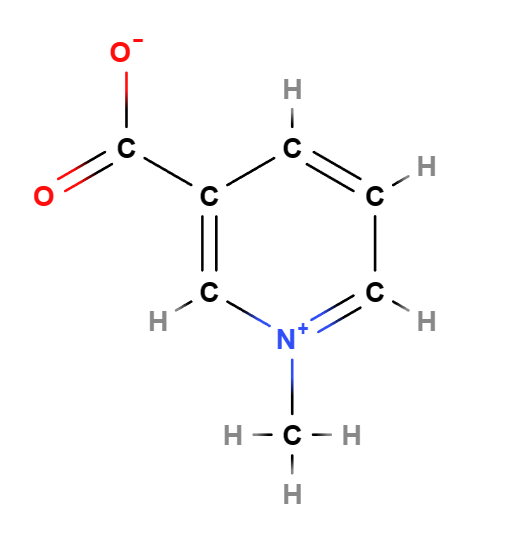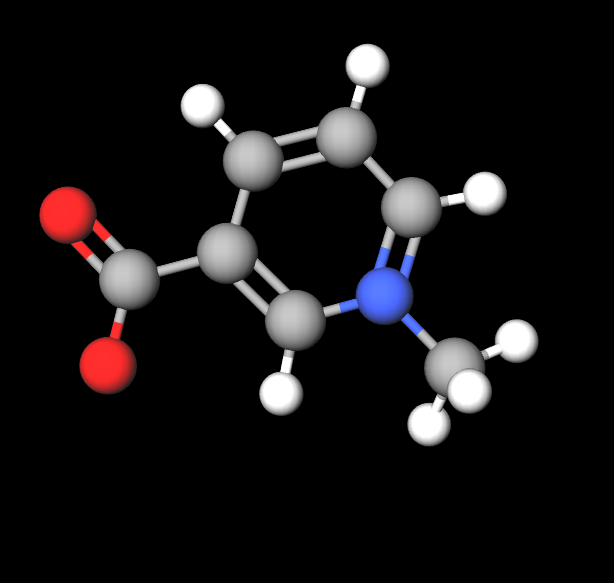| "Descrizione" by A_Partyns (12948 pt) | 2023-Sep-18 17:58 |
Review Consensus: 8 Rating: 8 Number of users: 1
| Evaluation | N. Experts | Evaluation | N. Experts |
|---|---|---|---|
| 1 | 6 | ||
| 2 | 7 | ||
| 3 | 8 | ||
| 4 | 9 | ||
| 5 | 10 |
Trigonelline is an alkaloid, a plant hormone also called nicotinic acid.It is a product of the metabolism of niacin or Vitamin B3.
The name "Trigonelline" is derived from "Trigonella", the Latin name for the genus of plants known as fenugreek, from which this molecule was first isolated.
From where it is extracted
It is found in many plants among the fenugreek (Trigonella foenum-graecum L.) which gave it its name, coffee and others, as well as in seafood and sea sponges.
Description of raw materials used in production and their functions.
- Methyl nicotinate. This is the esterified form of vitamin B3 and acts as a starting point for the synthesis of trigonelline.
- Water. Acts as a solvent and reaction medium.
It appears in the form of a white powder.

Step-by-step summary of industrial chemical synthesis process.
- Hydrolysis. Methyl nicotinate undergoes hydrolysis in an acidic environment to form nicotinic acid and methanol.
- Salt formation. The nicotinic acid reacts with a base, such as sodium hydroxide, to form its salt, trigonelline.
- Crystallization. The solution containing trigonelline is cooled to allow the formation of pure crystals.
- Filtration and drying. Trigonelline crystals are then filtered and subsequently dried.
Medical
Trigonella has been shown to be useful in the prevention and treatment of diabetes and central nervous system diseases (1), protection of the heart and liver, and treatment of hyperglycemia, hypercholesterolemia, nervous and hormonal disorders, and cancer (2, a candidate for inhibition of cancer cell invasion (3).
Commercial Applications
Coffee Industry. Trigonelline is one of the primary compounds in coffee beans and contributes to aroma formation during roasting.
Dietary Supplements. As it's found in fenugreek seeds, trigonelline might be a component of dietary supplements derived from fenugreek.
 |  |
- Molecular Formula C7H7NO2
- Molecular Weight 137.138 g/mol
- CAS 535-83-1
- EC number 208-620-5
- UNII 3NQ9N60I00
- DTXSID2026230
- Nikkaji J1.414.545A
Synonyms:
1-Methylpyridinium-3-carboxylate monohydrate
Trigonelline monohydrate
Bibliografia__________________________
(1) Zhou J, Chan L, Zhou S. Trigonelline: a plant alkaloid with therapeutic potential for diabetes and central nervous system disease. Curr Med Chem. 2012;19(21):3523-31. doi: 10.2174/092986712801323171.
Abstract. There is evidence that Trigonella foenum-graecum L. (fenugreek), a traditional Chinese herb, and its components are beneficial in the prevention and treatment of diabetes and central nervous system disease. The pharmacological activities of trigonelline, a major alkaloid component of fenugreek, have been more thoroughly evaluated than fenugreek's other components, especially with regard to diabetes and central nervous system disease. Trigonelline has hypoglycemic, hypolipidemic, neuroprotective, antimigraine, sedative, memory-improving, antibacterial, antiviral, and anti-tumor activities, and it has been shown to reduce diabetic auditory neuropathy and platelet aggregation. It acts by affecting β cell regeneration, insulin secretion, activities of enzymes related to glucose metabolism, reactive oxygen species, axonal extension, and neuron excitability. However, further study of trigonelline's pharmacological activities and exact mechanism is warranted, along with application of this knowledge to its clinical usage. This review aims to give readers a survey of the pharmacological effects of trigonelline, especially in diabetes, diabetic complications and central nervous system disease. In addition, because of its pharmacological value and low toxicity, the reported adverse effects of trigonelline in experimental animal models and humans are briefly reviewed, and the pharmacokinetics of trigonelline are also discussed.
(2) Mohamadi N, Sharififar F, Pournamdari M, Ansari M. A Review on Biosynthesis, Analytical Techniques, and Pharmacological Activities of Trigonelline as a Plant Alkaloid. J Diet Suppl. 2018 Mar 4;15(2):207-222. doi: 10.1080/19390211.2017.1329244.
Abstract. Trigonelline (TRG) as a polar hydrophilic alkaloid is extracted from many plant species, for example, Trigonella foenum-graecum, Allium sepapea, Coffea sp, Pissum sativum, Glycine max, and Lycopersicon esculentum. Numerous biological activities have been reported for TRG such as protection of heart and liver and treatment of hyperglycemia, hypercholesterolemia, nervous and hormonal disorders, and cancers. Thus, the aim of this review is to summarize some information about TRG's biosynthesis pathway, pharmacological activity, pharmacokinetics, and analytical techniques to introduce TRG as an alternative choice to treat the various diseases. However, current evidence is still inadequate for introducing TRG as a novel drug, and it is necessary to examine more clinical trials to determine its acute and chronic side effects, bioavailability, pharmacokinetic parameters, and mechanisms of action.
(3) Jeong YI, Kim DH, Chung KD, Kim YH, Lee YS, Choi KC. Antitumor activity of trigonelline-incorporated chitosan nanoparticles. J Nanosci Nanotechnol. 2014 Aug;14(8):5633-7. doi: 10.1166/jnn.2014.8818.
Abstract. In this study, trigonelline, a niacin-related compound was incorporated into chitosan nanoparticles through ion-complex formation between anionic carboxylic acid group of trigonelline and cationic amine group of chitosan. Morphology of trigonelline-incorporated chitosan nanoparticles have spherical shape with less than 500 nm in size and thier size distribution showed quite unimodel phase. Even though trigonelline and trigonelline-incorporated chitosan nanoparticles were not significantly affected to the proliferation of tumor cells, invasion of tumor cells was effectively inhibited by trigonelline-incorporated chitosan nanoparticles. We suggested that trigonelline-incorporated chitosan nanoparticles are promising candidate for inhibition of tumor cell invasion.
| Evaluate |

